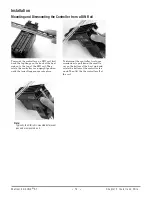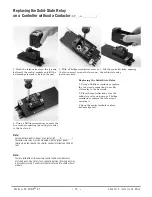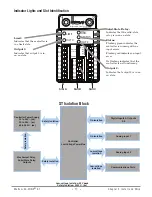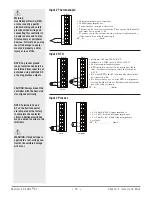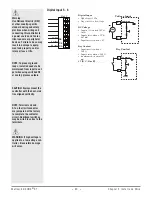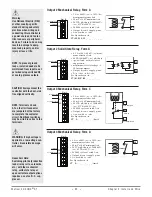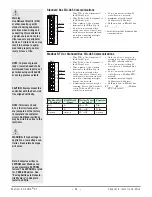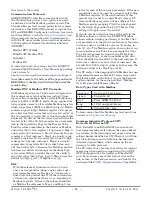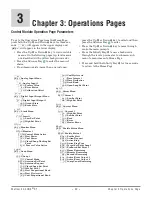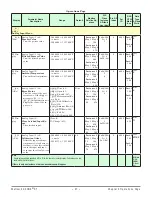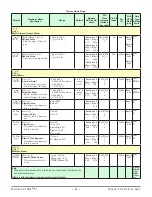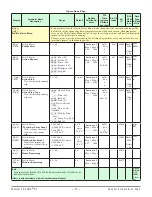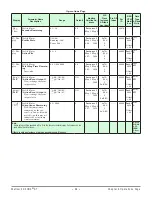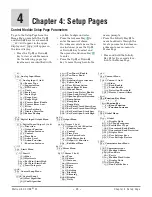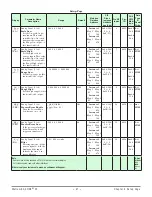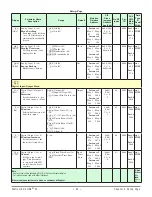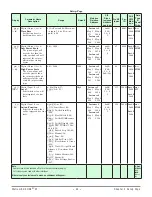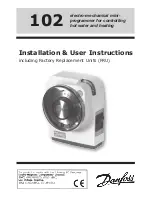
Watlow EZ-ZONE
®
ST
•
28
•
Chapter 2 Install and Wire
that value to the control.
Communication Protocols
All EZ-ZONE ST controllers come standard with
the Standard Bus protocol. As a option it can also
be delivered with the Modbus protocol as well. The
Standard Bus protocol is used primarily for commu-
nications to other EZ-ZONE products to include the
RUI and EZ-ZONE Configurator software (free down-
load from Watlow's web site (
http://www.watlow.com
).
Other protocols that can be used to communicate
with the ST are available when used in conjunction
with the optional Remote User Interface/Gateway
(RUIGTW).
- Modbus RTU 232/485
- EtherNet/IP, Modbus TCP
- DeviceNet
- Profibus DP
If interested in learning more about the RUI/GTW
download the RUI/Gateway User Manual by pointing
your browser to:
http://www.watlow.com/literature/pti_search.cfm?dltype=5
Once there move to the bottom of the page and enter
EZ-ZONE into the Keyword field and then click the
search button.
Modbus RTU & Modbus TCP Protocols
All Modbus registers are 16-bits and as displayed in
this manual are relative addresses (actual). Some
legacy software packages limit available Modbus reg-
isters to 40001 to 49999 (5 digits). Many applications
today require access to all available Modbus registers
which range from 400001 to 465536 (6 digits). Watlow
controls support 6 digit Modbus registers. For param-
eters listed as float notice that only one (low order) of
the two registers is listed, this is true throughout this
document. By default the low order word contains the
two low bytes of the 32-bit parameter. As an example,
look in the Operations Page for the Process Value.
Find the column identified in the header as Modbus
and notice that it lists register 19 (instance 1, Map 1)
and register 360 (instance 1, Map 2). Because this pa-
rameter is a float instance 1 Map 1 is actually repre-
sented by registers 19 (low order bytes) and 20 (high
order bytes), likewise, instance 1 Map 2 is actually
represented by registers 360 (low order bytes) and
361 (high order bytes). Because the Modbus specifica-
tion does not dictate which register should be high
or low order Watlow provides the user the ability to
swap this order (Setup Page,
[Com
Menu) from the
default low/high
[lohi]
to high/low
[hilo]
.
Note:
With the release of firmware revision 3.00 and
above new capabilities (phase angle control, user
programmable memory blocks, etc...) where intro-
duced into this product line. With the introduction
of these new capabilities there was a repacking of
Modbus registers. Notice in the column identified
as Modbus the reference to Map 1 and Map 2 reg-
isters for each of the various parameters. If the new
capabilities are to be used, be certain to select Map
2 Modbus registers. If the new functions of this
product line are not to be used, Map 1 (legacy ST
controls) Modbus registers will be sufficient. The
Modbus register mapping
[map]
can be changed
in the Setup Page under the
[Com]
Menu. This
setting will apply across the control.
It should also be noted that some of the cells in the
Modbus column as well as the RUI/GTW Modbus
column contain wording pertaining to an offset. Sev-
eral parameters in the control contain more than one
instance; such as, profiles (4), alarms (2), analog in-
puts (2), etc... The Modbus register shown always rep-
resents instance one. Take for an example the Step
Type
[styp]
parameter found in the Profile Page.
Instance one, Map 1, is shown as address 500 and
+20 is identified as the offset to the next instance. If
there was a desire to read or write to instance 3 sim-
ply add 40 to 500 to find its address. In this case, the
instance 3 address for Step Type is 540.
The ST control, when equipped with Modbus has user
programmable memory blocks. To learn more about
this feature click on the link or turn to the Features
section and look for the section entitled "
User Programmable Memory Blocks
Data Types Used with Modbus
unsigned
= Unsigned 16 bit integer
signed
= Signed 16-bit
float
= Float, IEEE 754 32-bit
long
= 32 bit unsigned integer
sint
= Signed 8 bits , byte
To learn more about the Modbus protocol point your
browser to
http://www.modbus.org
.
Common Industrial Protocol (CIP)
DeviceNet & Ethernet/IP
Both DeviceNet and EtherNet/IP use open object
based programming tools and use the same address-
ing scheme. In the following menu pages notice the
column header identified as CIP. There you will find
the Class, Instance and Attribute in hexadecimal,
(decimal in parenthesis) which makes up the ad-
dressing for both protocols.
The ST control has a feature that allows for implicit
messaging when used in conjunction with an RUI/
GTW equipped with a DeviceNet or EtherNet/IP
card. To learn more about this feature click on the
link or turn to the Features section and look for the
section entitled "
CIP - Communications Capabilities
".

